First under Soviet rule, then in the remarkable flourishing of a liberated nation, Estonian contemporary music has held its independent head high and showcased it, under the aegis of the Estonian Composers' Union, first for a few days and now for more than a week in spring. In this, its 40th anniversary year, Estonian Music Days became World Music Days, hosting composers from 60 countries as the base for the 96-year old ISCM. Maybe it was partly because Estonia, Latvia and Lithuania understand the two aspects of its chosen theme, "Through the Forest of Songs", so well that they still came out best in the nine events I witnessed across three days of this year's festival.
Another part of the secret lies in the fact that Estonia and Latvia have some of the top professional choirs in the world. Composers know that anything they write for them will be delivered with impeccable sound and style. I heard three such choirs in perfect ecclesiastical settings (and just missed a fourth, the stupendous Vox Clamantis, on the evening after my departure). Collegium Musicale under Endrik Üksvärav resonated among the heraldic shields of the Dome Church in the very heart of old Tallinn on Toompea Hill. "Futile Spells,", the title of the concert, was also that of Canadian Gabriel Dharmoo's ritualistic sequence (the composer pictured below by Sven Tupits). The question asked by the conductor - should we trust the systems that produced the spells, or believe in their magic? - was partly answered by some of the mesmerising ululations: music achieves the numinous. 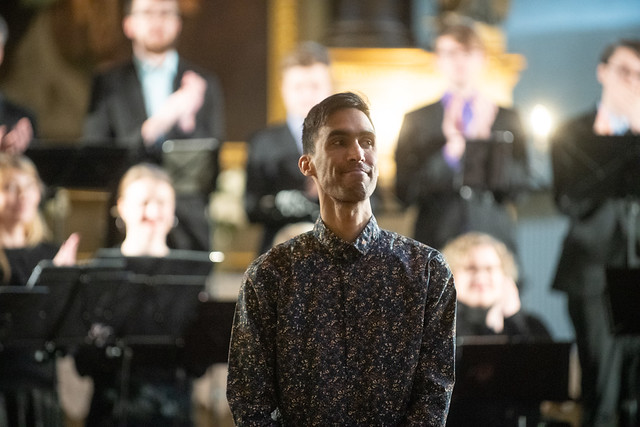 Where it doesn't is if the composer adopts the ritual and doesn't fully absorb it. Though Peeter Vähi's presence as reciter and wielder of shamanic drum in his Siberian Trinity Mantra, an Estonian Music Days commission, was as consummate as the choral singing, the results felt ersatz to me. Clearly conductor Neeme Järvi, in the audience, didn't agree, since he gave it a very heartfelt standing ovation. More of an impact, perhaps, came from Swede Catharina Palmér's open-ended settings of early Joyce poems dealing with the magic of music and the rich tapestry of sound effects in Mihyun Woo's Voices in Landscape.
Where it doesn't is if the composer adopts the ritual and doesn't fully absorb it. Though Peeter Vähi's presence as reciter and wielder of shamanic drum in his Siberian Trinity Mantra, an Estonian Music Days commission, was as consummate as the choral singing, the results felt ersatz to me. Clearly conductor Neeme Järvi, in the audience, didn't agree, since he gave it a very heartfelt standing ovation. More of an impact, perhaps, came from Swede Catharina Palmér's open-ended settings of early Joyce poems dealing with the magic of music and the rich tapestry of sound effects in Mihyun Woo's Voices in Landscape.
It might have been the indigestibility of two choral concerts within a short space of time that weakened the full impact of the Estonian Philharmonic Chamber Choir's concert in the Niguliste Church. The keynote here was dense, static music. Leading Estonian composer Helena Tulve never produces anything less than beautifully crafted; her settings of Paul Celan and Hilde Domin held at their heart chords rich and ambiguous even by the standards of what the EPCC can achieve.
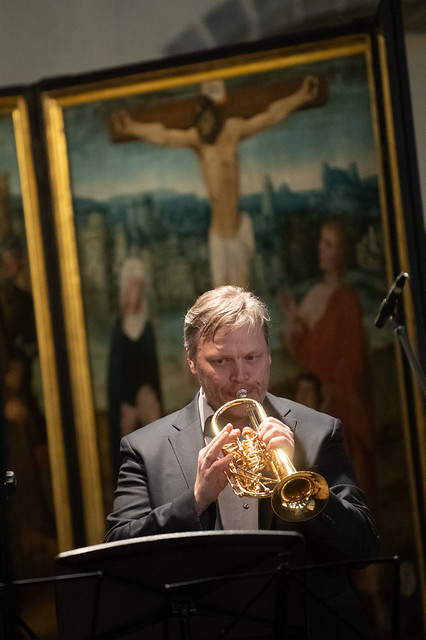 The enervating effect of Toivo Tulev's Tower of Babel Ek het joy lief, though, made it hard to succumb to the spirituality of Wim Henderickx's Blossomings: Three Prayers for a Better World, originally composed for the BBC Singers as a memorial to Jonathan Harvey. Context is all, and this felt like the wrong place for it at the end of a long choral sequence. Still, Indrek Vau's dazzling trumpet playing (pictured left by Sven Tupits) gained as much from the perfect acoustics of Tallinn's church-museum of ecclesiastical art as did the choir; the sheer luminosity of the sound remained a pleasure throughout.
The enervating effect of Toivo Tulev's Tower of Babel Ek het joy lief, though, made it hard to succumb to the spirituality of Wim Henderickx's Blossomings: Three Prayers for a Better World, originally composed for the BBC Singers as a memorial to Jonathan Harvey. Context is all, and this felt like the wrong place for it at the end of a long choral sequence. Still, Indrek Vau's dazzling trumpet playing (pictured left by Sven Tupits) gained as much from the perfect acoustics of Tallinn's church-museum of ecclesiastical art as did the choir; the sheer luminosity of the sound remained a pleasure throughout.
Unquestionably the richest programme of the three choral events I attended, though, belonged to the Latvian Radio Choir in the south-eastern university town of Tartu. Two and a half hours' drive (or train journey) from Tallinn through a landscape of fields, woods and the very rare settlement, it feels in the middle of nowhere and yet has all the amenities, museums and eateries to justify its claim to European Capital of Culture 2024. We began our big day out feted by a local band outside the vast new Estonian Museum, built on an airfield to the north of the town. Tartu is where the idea for the great choral festivals of tens of thousands began – the next is due this summer – and the village group (pictured below) gave us a break from contemporary fare with a repertoire including some of the early national song-melodies.
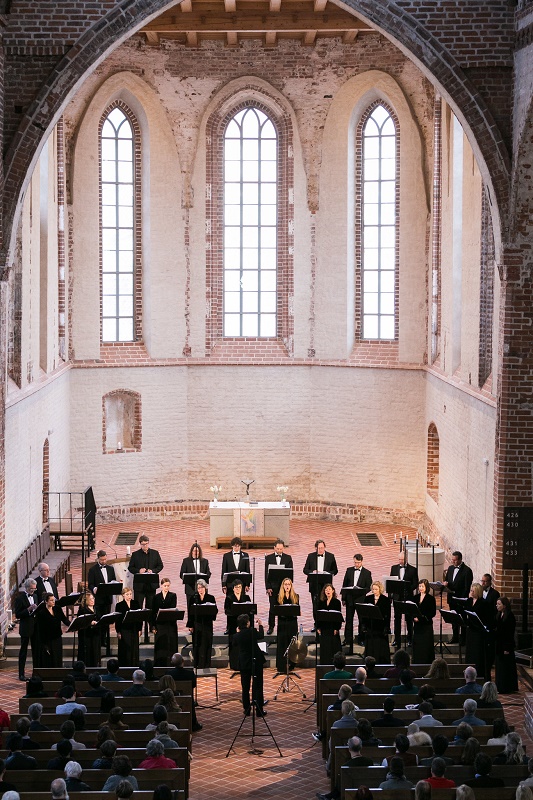 It was a release to walk into the old town via the botanic gardens for the choral concert in St John’s Church (Jaani Kirik), a 14th century eccentricity of brick and hundreds of terracotta heads and statues, cleanly restored. So many pieces in the festival progress indeterminately and seem ready to end long before they do, but there was only one of that kind here, Mārtiņš Viļums’ concluding On the Conflict Waged with the Primeval Ox. His compatriot Andris Dzenītis' hypnotic setting of American poet Rick Bursky’s Aerodynamics, though, still resonates in the mind. The Latvians (pictured right by Jaak Nilson), here conducted superbly by Kaspars Ādamsons, can do anything, not least bending the multi-part chords while still keeping pitch. Choral singing doesn’t get better than this.
It was a release to walk into the old town via the botanic gardens for the choral concert in St John’s Church (Jaani Kirik), a 14th century eccentricity of brick and hundreds of terracotta heads and statues, cleanly restored. So many pieces in the festival progress indeterminately and seem ready to end long before they do, but there was only one of that kind here, Mārtiņš Viļums’ concluding On the Conflict Waged with the Primeval Ox. His compatriot Andris Dzenītis' hypnotic setting of American poet Rick Bursky’s Aerodynamics, though, still resonates in the mind. The Latvians (pictured right by Jaak Nilson), here conducted superbly by Kaspars Ādamsons, can do anything, not least bending the multi-part chords while still keeping pitch. Choral singing doesn’t get better than this.
Operatic standards are high, too, as we witnessed down by the river Emajogi which for centuries was the lifeblood of Hanseatic Tartu. In the perfect harbour venue, Estonia’s leading Vanemuine Theatre reprised the 2017 success of Into the Fire by Märt-Matis Lill, Estonian Composer’s Union chairman and co-artistic director of Music Days with Timo Steiner. It’s a dangerous task to take on the subject of the First World War in general instead of coming at it from a specific viewpoint (like the Isango Ensemble’s splendid music-theatre SS Mendi: Dancing the Death Drill). 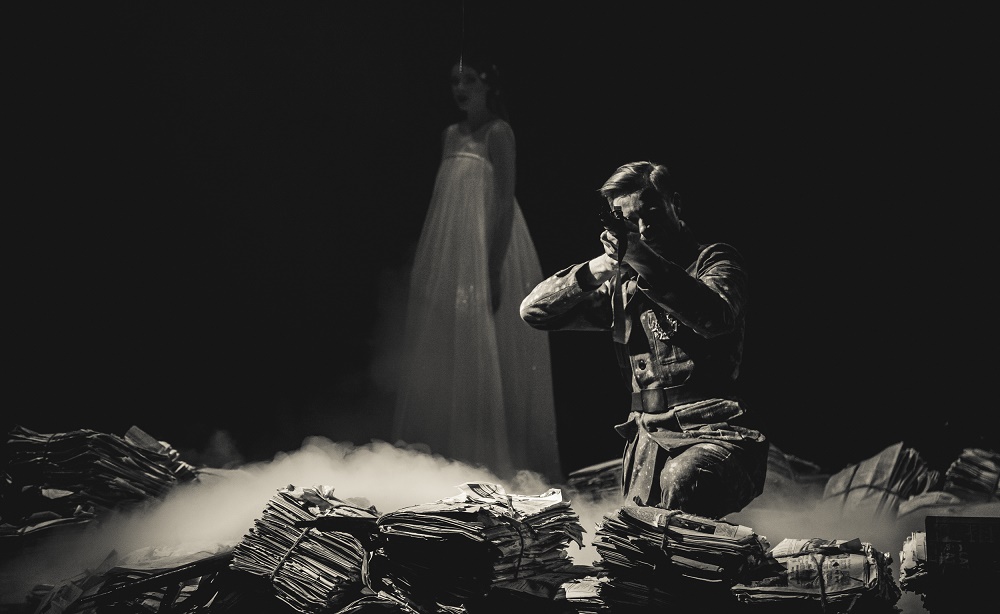 A major two-act opera is a tall order too, and it was hardly surprising if the trench scenes were of varying quality, though cleverly staged by Taago Tubin. But there was plenty here to admire; and the decision of Lill with his librettist Jan Kaus to counterpoint the events of 1914-17 with texts from Homer’s Iliad and ancient Greek drama sung by a chorus with key solos for women culminated in a masterly sequence: two monologues for Andromache delivered with still intensity by Kadi Jürgens (pictured above in a secne from the opera by Maris Savik). When I spoke to the affable Lill later, I mentioned these and he told me they were his starting point.
A major two-act opera is a tall order too, and it was hardly surprising if the trench scenes were of varying quality, though cleverly staged by Taago Tubin. But there was plenty here to admire; and the decision of Lill with his librettist Jan Kaus to counterpoint the events of 1914-17 with texts from Homer’s Iliad and ancient Greek drama sung by a chorus with key solos for women culminated in a masterly sequence: two monologues for Andromache delivered with still intensity by Kadi Jürgens (pictured above in a secne from the opera by Maris Savik). When I spoke to the affable Lill later, I mentioned these and he told me they were his starting point.
Mostly Estonian instrumentalists held the fort on a Tallinn Sunday in two guild halls. The House of the Blackheads, a guild of young, single merchants and foreigners in Hanseatic Tallinn who took the Moorish Saint Mauritius as their patron, hosted two more superlative concerts. The acoustics of its downstairs hall, funnelling out from the performing space at the end with windows, are as perfect for pianos as the Niguliste Church is for choirs; I could have sworn that Kadri-Ann Sumera and Talvi Hunt (pictured below by Karin-Liis Tanbaum) were "sound-treated", but, electronics apart, that wasn’t the case. There was more evocative wood magic from an Estonian, Madli Marje Sink’s Dream Sequence of an Ancient Forest, and a much-needed injection of rhythmic energy from a classic, a movement from Raimo Kangro’s Sonata for two pianos. Arpeggiating virtuosity was a keynote, pretty and shapely in Yulan Qiu’s Butterfly Dance (for Sumera alone), contrasted with granitic chords in Romanian composer Livia Teodorescu-Ciocănea’s Magner Mater. Cybele. 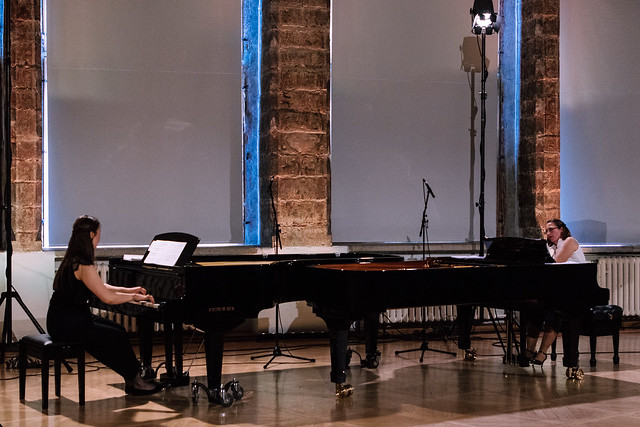 The strings of the splendid Tallinn Chamber Orchestra, conducted by the energetic and genial Risto Joost, could have overwhelmed the room, but they stayed on the right side of vibrant in another burst of vitality among the mood-music pieces from Jonas Tarm; his Memories of the Earth is a work that would serve any string ensemble well. All subtle atmospherics, Canvas was a work of guaranteed excellence from Liisa Hirsch (pictured below embracing Joost by Sven Tupits), winner of a major prize at the the 2016 Estonian Music Days. Let’s just say of the Ensemble for New Music Tallinn’s multi-media sequel in the Hall of the St Canute's Guild that it produced a good few laughs in Alexander Schubert’s technology-gone-awry Star Me Kitten and some exquisite playing from flautist Marie Elonen in Shai Cohen’s Noumenon; the rest belonged to the lunatic fringe.
The strings of the splendid Tallinn Chamber Orchestra, conducted by the energetic and genial Risto Joost, could have overwhelmed the room, but they stayed on the right side of vibrant in another burst of vitality among the mood-music pieces from Jonas Tarm; his Memories of the Earth is a work that would serve any string ensemble well. All subtle atmospherics, Canvas was a work of guaranteed excellence from Liisa Hirsch (pictured below embracing Joost by Sven Tupits), winner of a major prize at the the 2016 Estonian Music Days. Let’s just say of the Ensemble for New Music Tallinn’s multi-media sequel in the Hall of the St Canute's Guild that it produced a good few laughs in Alexander Schubert’s technology-gone-awry Star Me Kitten and some exquisite playing from flautist Marie Elonen in Shai Cohen’s Noumenon; the rest belonged to the lunatic fringe. 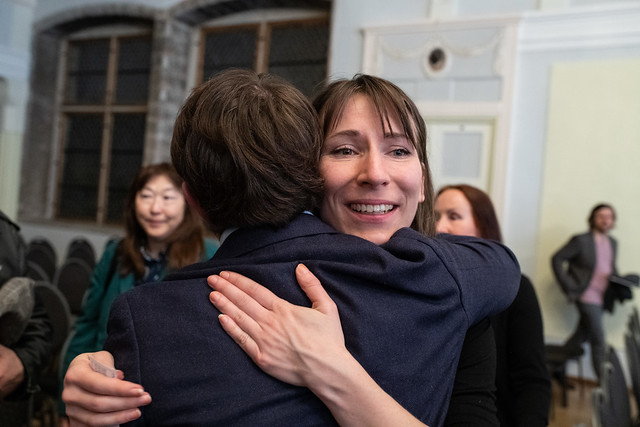 The play of sound and silence found its extreme refinement on Tuesday afternoon. The circumstances were emotional: when I last visited the Arvo Pärt Centre near the great man’s composing home on the Lohusalu peninsula, it was a forest clearing. Now we took the same path through the woods, and there stood the fully-realised results of winning architect Nieto Sobejano's beautiful, curvaceous, nature-sensitive design. Finishing touches were being put to the Orthodox frescoes of the stand-apart chapel by an icon-painter priest; six of us were the second group to be conducted up the tower above the trees with its view out to the bay and the sea.
The play of sound and silence found its extreme refinement on Tuesday afternoon. The circumstances were emotional: when I last visited the Arvo Pärt Centre near the great man’s composing home on the Lohusalu peninsula, it was a forest clearing. Now we took the same path through the woods, and there stood the fully-realised results of winning architect Nieto Sobejano's beautiful, curvaceous, nature-sensitive design. Finishing touches were being put to the Orthodox frescoes of the stand-apart chapel by an icon-painter priest; six of us were the second group to be conducted up the tower above the trees with its view out to the bay and the sea.  Here was the 83-year old composer mingling naturally with his younger colleagues, and sitting attentive, sometimes with hands cupped to ears (above and below images by Rene Jakobson), in the beautiful concert hall with its window on to the woods as koto player Naoko Kikuchi and Krist Mühling, leading exponent of the Estonian kannel – relation of the Finnish kantele – tested the threshhold of audibility.
Here was the 83-year old composer mingling naturally with his younger colleagues, and sitting attentive, sometimes with hands cupped to ears (above and below images by Rene Jakobson), in the beautiful concert hall with its window on to the woods as koto player Naoko Kikuchi and Krist Mühling, leading exponent of the Estonian kannel – relation of the Finnish kantele – tested the threshhold of audibility. 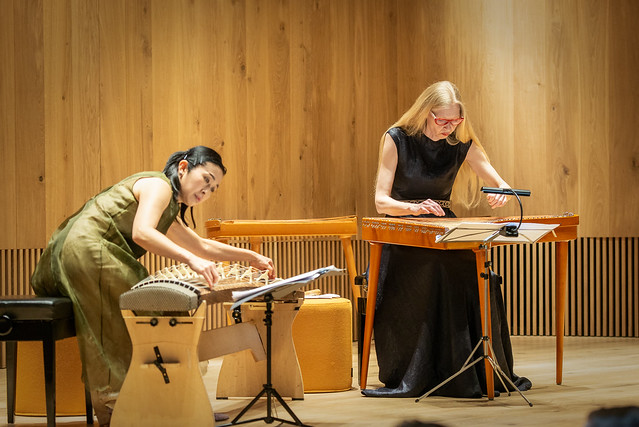 Apart from Irishman John Buckley’s ravishing Alla luna for kannel and Kikuchi’s bewitching treatment of a Japanese traditional song, the artistry excelled the substance of the works performed; as throughout the festival, composers knew they were hearing their works performed at the very highest level. Then, as encore, came the essential lesson of the master, in an arrangement of Pärt’s Summa: a fitting way to take leave of an exceptional country until a necessary return visit in the summer.
Apart from Irishman John Buckley’s ravishing Alla luna for kannel and Kikuchi’s bewitching treatment of a Japanese traditional song, the artistry excelled the substance of the works performed; as throughout the festival, composers knew they were hearing their works performed at the very highest level. Then, as encore, came the essential lesson of the master, in an arrangement of Pärt’s Summa: a fitting way to take leave of an exceptional country until a necessary return visit in the summer.

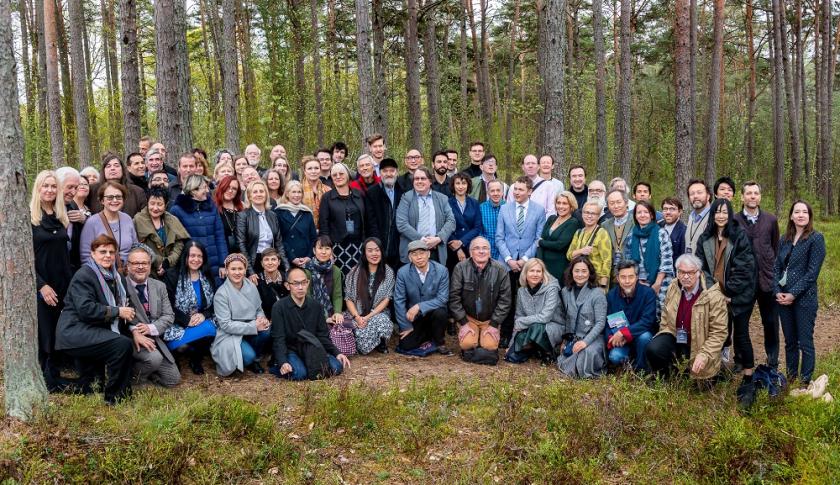













Add comment